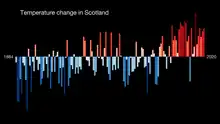
Climate change in Scotland is causing a range of impacts on Scotland, and its mitigation and adaptation is a matter for the devolved Scottish Parliament. Climate change has already changed timings of spring events such as leaf unfolding, bird migration and egg-laying. Severe effects are likely to occur on biodiversity.
Greenhouse gas emissions
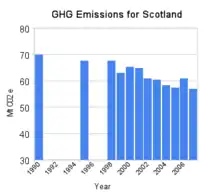
Scotland's greenhouse gas emissions only accounted for 10% of the UK's emissions[1] in 2003, when figures were published. 37% of Scottish emissions are in energy supply and 17% in transport. Between 1990 and 2007, Scottish net emissions have reduced by 18.7%.[2] The industrial processes sector had the largest decrease, of 72% with a reduction of 48% in the public sector trailing closely behind.
Impacts on the natural environment
Temperature and weather changes
In Scotland, the effects of climate change can be seen in raised temperature changes, increased rainfall and less snow cover. These changes have a significant impact on the growing, breeding and migration seasons, as well as species abundance and diversity.
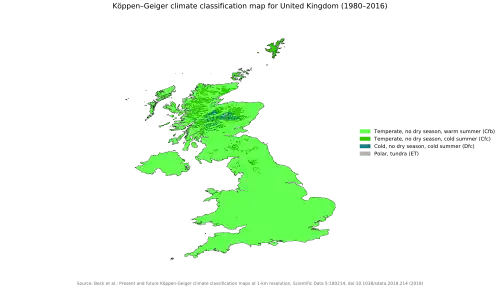
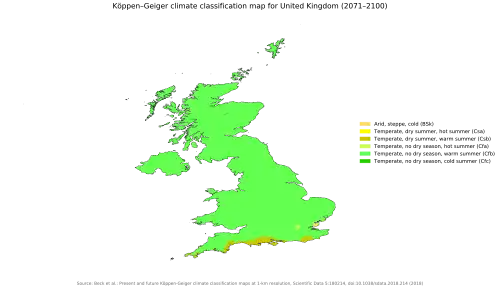
Ecosystems
Past observations have indicated some of the likely effects of climate change on biodiversity. Climate change has already changed timings of spring events such as leaf unfolding, bird migration and egg-laying. The population of species could change due to the speed at which they adapt.
Changes in the ranges of plant and animal species have been observed. New species may move to Scotland with the changing climate. Shifts may occur on hillsides and species that are already confined to high mountains may become extinct in Scotland.
Severe effects are likely to occur on biodiversity. Species of plants and animals that can't adapt quickly enough may become extinct or be replaced by other creatures. Coastal habitats, including machairs, may disappear due to high sea levels eroding the land. Salmon spawning beds may be wiped out by flash floods causing population problems for the species. There will be new risks to animals, plants and their habitats, including non-native pests and diseases.[3]
When all these effects are combined with human response, such as land use change and the growth of new forests, Scotland's ecosystems could change drastically.
Impacts on people
Economic impacts
Agriculture
In some cases, Scottish agriculture may experience a positive change as summers will be warmer and drier. A higher yields and the possibility of new crops being able to grow in Scotland. However, soil quality would lower with heat and soil moisture stress. The availability of fresh water could cause problems for livestock. Heat stress with warmer and wetter conditions, livestock could face new diseases such as West Nile virus and outbreaks of bluetongue or parasites could increase.[4]
Mitigation and adaptation
Policies and regulation
Climate Change Act
The Climate Change (Scotland) Act 2009 is an Act passed by the Scottish Parliament.[5] The Act includes an emissions target, set for the year 2050, for a reduction of at least 80% from the baseline year, 1990.[5] The Climate Change (Scotland) Act 2009 was amended by the Climate Change (Emissions Reduction Targets) (Scotland) Act 2019,[6] increasing the ambition of Scotland's emissions reduction targets to net zero by 2045 and revising interim and annual emissions reduction targets. Annual targets for greenhouse gas emissions must also be set, after consultation the relevant advisory bodies. Provisions are included in the Act for the creation of the Scottish Committee on Climate Change, as at present the only advisory body is the UK Committee on Climate Change.[5][7] Ministers in parliament must now report on the progress of these targets.[8] As of January 2011, public sector bodies in Scotland must comply with new guidelines set out by the Scottish Government.[9]
Protection and enforcement
The Scottish Environment Protection Agency (SEPA) is Scotland's environmental regulator.[10][11][12][13] SEPA's main role is in protecting and improving Scotland's natural environment. SEPA does this by helping communities, businesses and industries understand their legal and moral responsibilities they have relating to the environment.
SEPA recognises that climate change is the single greatest threat to our future. The organisation has produced its own climate change plan which contains details about how it will reduce its carbon emissions.[14] This five year climate change plan introduces SEPA's specific role in climate change mitigation. SEPA, Scottish Natural Heritage (SNH), Forestry and Land Scotland (FLS), Scottish Forestry and Historic Environment Scotland are all government funded organisations with responsibilities for different aspects of Scotland's environment and heritage. A joint statement on climate change was created by all partners in 2009.[15]
"The Scientific evidence is now overwhelming: climate change presents very serious global risks and it demands an urgent global response".[16]
Afforestation
Energy
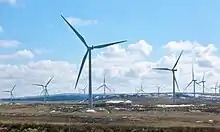
The production of renewable energy in Scotland is a topic that came to the fore in technical, economic, and political terms during the opening years of the 21st century.[21] The natural resource base for renewable energy is high by European, and even global standards, with the most important potential sources being wind, wave, and tide. Renewables generate almost all of Scotland's electricity, mostly from the country's wind power.[22]
In 2020, Scotland had 12 gigawatts (GW) of renewable electricity capacity, which produced about a quarter of total UK renewable generation.[23] In decreasing order of capacity, Scotland's renewable generation comes from onshore wind, hydropower, offshore wind, solar PV and biomass.[24] Scotland exports much of this electricity.[25][26]
Continuing improvements in engineering and economics are enabling more of the renewable resources to be used. Fears regarding fuel poverty[27] and climate change have driven the subject high up the political agenda. In 2020 a quarter of total energy consumption, including heat and transportation, was met from renewables, and the Scottish government target is half by 2030.[28] Although the finances of some projects remain speculative or dependent on market incentives, there has been a significant—and, in all likelihood, long-term—change in the underpinning economics.[29][30]
In addition to planned increases in large-scale generating capacity using renewable sources, various related schemes to reduce carbon emissions are being researched.[31] Although there is significant support from the public, private and community-led sectors, concerns about the effect of the technologies on the natural environment have been expressed. There is also a political debate about the relationship between the siting, and the ownership and control of these widely distributed resources.[32][33]International cooperation
.jpg.webp)
During a 2017 visit to the United States, the first minister Nicola Sturgeon met Jerry Brown, Governor of California, where both signed an agreement committing both the Government of California and the Scottish Government to work together to tackle climate change.[34]
The COP26 climate conference was held in Glasgow in 2021.[35]
See also
- Energy policy of Scotland
- Sustainable development in Scotland
- Climate change in the United Kingdom
- David Reay, a climate change scientist, author, and senior lecturer in carbon management at the University of Edinburgh
References
- ↑ http://www.scotland.gov.uk/Resource/Doc/283799/0086005.pdf GHG Emissions by sector
- ↑ http://www.scotland.gov.uk/Topics/Environment/climatechange/what-is/research-science Scottish Government- Climate Change
- ↑ Scotland's Climate Change Adaption Framework – Biodiversity and Ecosystem Resilience, Scottish Government. [Accessed 1 May 2010]
- ↑ Scotland's Climate Change Adaption Framework – Agriculture, Scottish Government.[Accessed 1 May 2010]
- 1 2 3 Climate Change (Scotland) Act 2009, London, HMSO. [Accessed 1 May 2010]
- ↑ https://www.gov.scot/policies/climate-change/
- ↑ http://www.scotland.gov.uk/Topics/Environment/climatechange/scotlands-action/climatechangeact/advisorybody Advisory Body
- ↑ Scottish Government report on 2010 emissions.
- ↑ http://www.scotland.gov.uk/Topics/Environment/climatechange/scotlands-action/climatechangeact/publicsector Duties on public sector bodies
- ↑ Scottish Government, Scotland's Higher Activity Radioactive Waste Policy: Consultation 2010, Part 7, 5.02.02 [Accessed 29 April 2010]
- ↑ Environment Act (1995). (c.2), London, HMSO [Accessed 29 April 2010].
- ↑ LE Law and Your Environment, The plain guide to environmental law website [Accessed 29 April 2010]
- ↑ The UK Environmental Law Association website [Accessed 29 April 2010]
- ↑ SEPA's Climate Change Plan Archived 6 January 2011 at the Wayback Machine [Accessed 1 May 2010]
- ↑ Action on Climate Change – joint statement of intention publication, 2009 Archived 6 January 2011 at the Wayback Machine, SEPA, SNH, Historic Scotland, FCS [Accessed 30 April 2010]
- ↑ The Economics of Climate Change, October 2006: Stern Review Archived 28 October 2008 at the Wayback Machine [Accessed 30 April 2010]
- ↑ Smout, T C; MacDonald, R; Watson, Fiona (2007). A History of the Native Woodlands of Scotland 1500–1920. Edinburgh University Press. ISBN 978-0-7486-3294-7.
- ↑ "Woodland expansion across Scotland". NatureScot. Retrieved 29 November 2019.
- ↑ "Draft Climate Change Plan: The draft third report on policies and proposals 2017-2032" (PDF). Government of Scotland. January 2017.
- ↑ "Whitelee Windfarm". ScottishPower Renewables. Retrieved 31 December 2020.
- ↑ See, for example, Scottish Executive (2005) Choosing Our Future: Scotland's Sustainable Development Strategy. Edinburgh.
- ↑ "Renewables met 97% of Scotland's electricity demand in 2020". BBC News. British Broadcasting Corporation. 25 March 2021. Retrieved 31 March 2021.
- ↑ "BEIS Energy Trends – Renewables". UK Government. 26 March 2020. Retrieved 15 April 2020.
- ↑ "Statistics". Scottish Renewables. Retrieved 22 April 2023.
- ↑ "Proportion of electricity generation by fuel". Scottish Government: Scottish Energy Statistics Hub. Retrieved 15 April 2020.
- ↑ "Share of renewable electricity in gross final consumption". Scottish Government: Scottish Energy Statistics Hub. Retrieved 15 April 2020.
- ↑ Wray, Ben (5 June 2022). "April Fuel's Day: Explaining Scotland's energy price rises". The National. Retrieved 11 July 2022.
- ↑ "Energy statistics". www.gov.scot. Retrieved 11 July 2022.
- ↑ Monbiot, George (2006). Heat: How to Stop the Planet Burning. London: Allen Lane. ISBN 978-0-71399-924-2. OCLC 70173475.
- ↑ Valenti, Martin (2020) "Scotland's leading role in the journey to a sustainable, low-carbon future". Scottish Enterprise. Retrieved 7 February 2021.
- ↑ "Ending Scotland's Contribution to Climate Change". Scottish Government. Retrieved 15 April 2020.
- ↑ HICEC. (2006) Highlands and Islands Community Energy Company Annual Review. HICEC. Inverness. Archived 8 May 2007 at the Wayback Machine. (PDF). Retrieved 31 August 2007.
- ↑ "Scottish communities reap £20m in benefits from renewable energy projects". Local Energy Scotland. Retrieved 15 April 2020.
- ↑ "Sturgeon signs climate agreement with California". BBC News. 3 April 2017. Retrieved 1 August 2018.
- ↑ Carbon Brief Staff (15 November 2021). "COP26: Key outcomes agreed at the UN climate talks in Glasgow". Carbon Brief. Retrieved 22 April 2023.
External links
- Cairngorms Climate An investigation of climate change in the Scottish highlands.
- Scottish Environment Protection Agency
- Climate Change from the UCB Libraries GovPubs
- Climate Change from the Met Office (UK)
- Global Climate Change from NASA (US)
- SNIFFER: A handbook of climate trends across Scotland